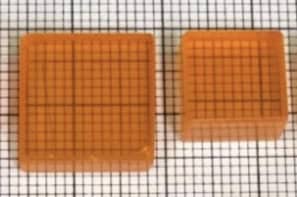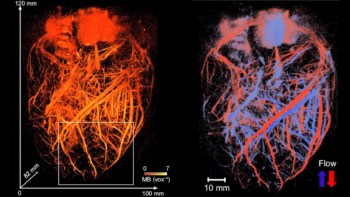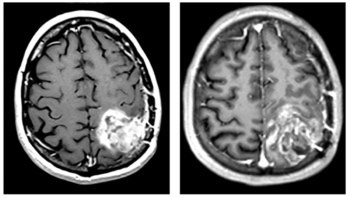
The uEXPLORER is a 194-cm-long total-body PET/CT scanner developed by a research team at UC Davis and manufactured by United Imaging Healthcare of Shanghai. The UC Davis team has now shown that combining this ultrasensitive scanner with an advanced image reconstruction method enables capture of real-time videos of blood flow and heart function (PNAS 10.1073/pnas.1917379117).
The researchers developed a method to perform ultrahigh-temporal-resolution dynamic PET, based on the use of kernel expectation maximization reconstruction. Working with Zhongshan Hospital, they tested their proposed approach by injecting 256 MBq of the PET tracer 18F-FDG into a leg vein of a healthy 60-year-old female volunteer. Immediately after injection, they used the uEXPLORER to perform a 60 min total-body dynamic scan.
To demonstrate the high temporal resolution for capturing fast tracer dynamics and real-time cardiac motion, the researchers divided the first minute of recorded PET data into 100 ms frames and reconstructed more than 600 consecutive frames. The reconstructed images demonstrated the scanner’s ability to visualize cardiac motion with high clarity, capturing changes in the cardiac blood pool, with clear delineation of the end-systolic and end-diastolic phases.
The team also created a video of the injected tracer travelling through the body with 100 ms temporal resolution. The video shows the tracer moving up the body to the heart, flowing through the right ventricle to the lungs, back through the left ventricle and on to the rest of the body.
“The breakthrough in this work is to capture the ultrafast whole-body dynamic tracer imaging with EXPLORER at the same time,” says UC Davis’ Jinyi Qi. “We can see global changes with improved image quality at a timescale of 100 ms, which was never seen before using any medical imaging modalities.”
The team generated time–activity curves (TACs) in four regions-of-interest – within the left ventricle (LV), ascending aorta, descending aorta and myocardium – during the first minutes after tracer injection. The curves showed a staircase pattern as new blood entered the LV in the diastolic phase of the cardiac cycle (during which, radiotracer concentration in the LV changed) and was pumped into the aorta in the systolic phase (when concentration in the aorta changed).
The researchers also observed that the TAC of the descending aorta was lower than those of the LV and ascending aorta and that the myocardium TAC had a clear cyclical rhythm from the heartbeat. They point out that none of these observations would be possible at the lower temporal resolution previously used in dynamic PET imaging.
The uEXPLORER’s ability to create dynamic PET images on 100 ms timescales should allow study of cardiovascular function, fast pharmacodynamics, use of shorter-lived radionuclides, and characterization of normal and abnormal brain function by measuring cerebral blood flow and cerebral metabolic rate of oxygen.
The high temporal resolution can also be used to freeze motion, either physiological (such as cardiac and respiratory motion) or involuntary body motion, which improves the spatial resolution of reconstructed images. Finally, the researchers note that high temporal resolution combined with uEXPLORER’s total-body coverage could enable new studies examining the dynamic function and interaction of multiple organs – such as the brain and heart, or the brain and gut – simultaneously.
“Currently the uEXPLORER scanner is routinely used at UC Davis for both clinical scans and a variety of research studies,” Qi tells Physics World. “For the high temporal resolution total-body PET, we plan to use it to study cardiac functions and also brain-heart interactions in the near future.”



